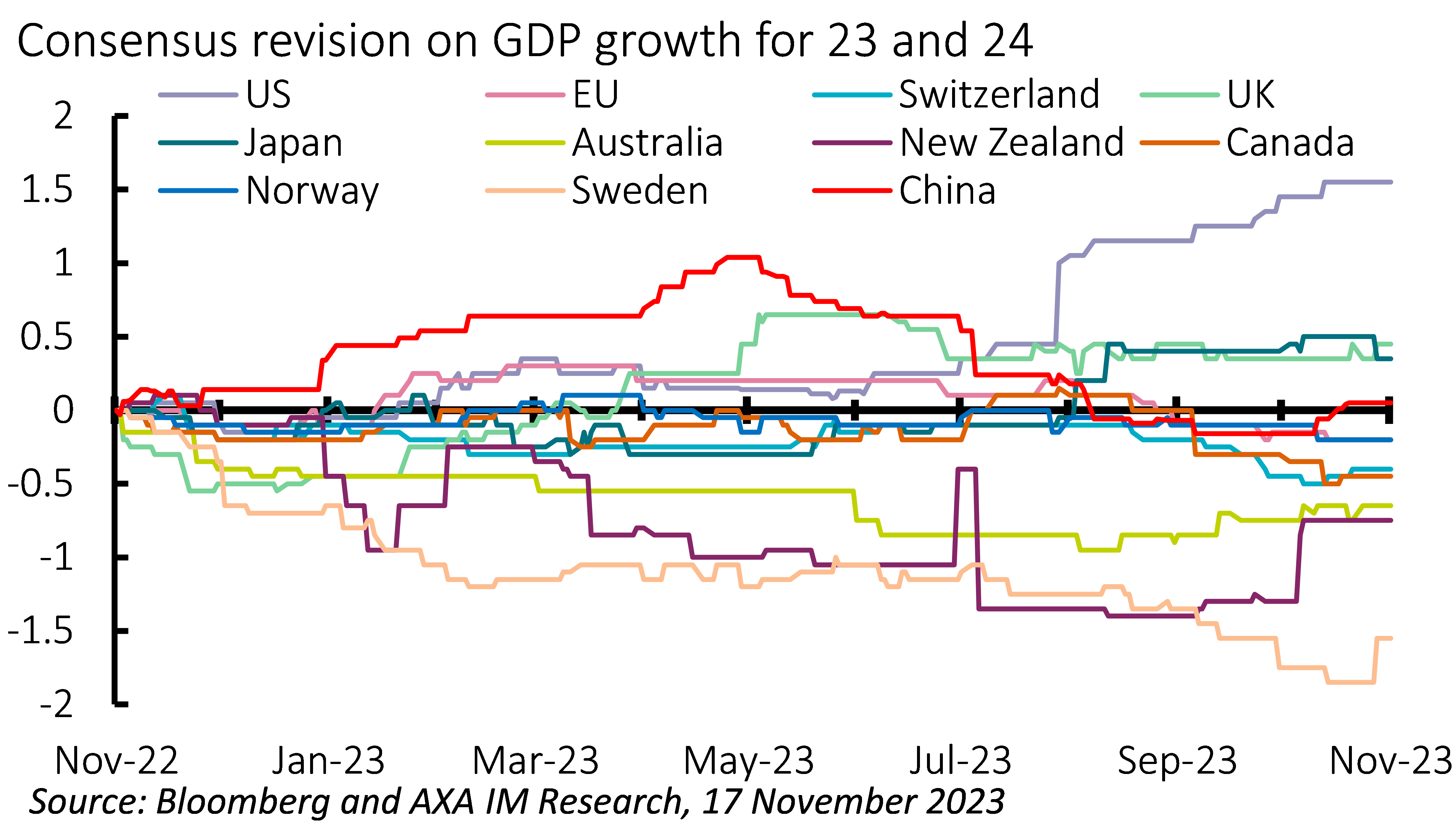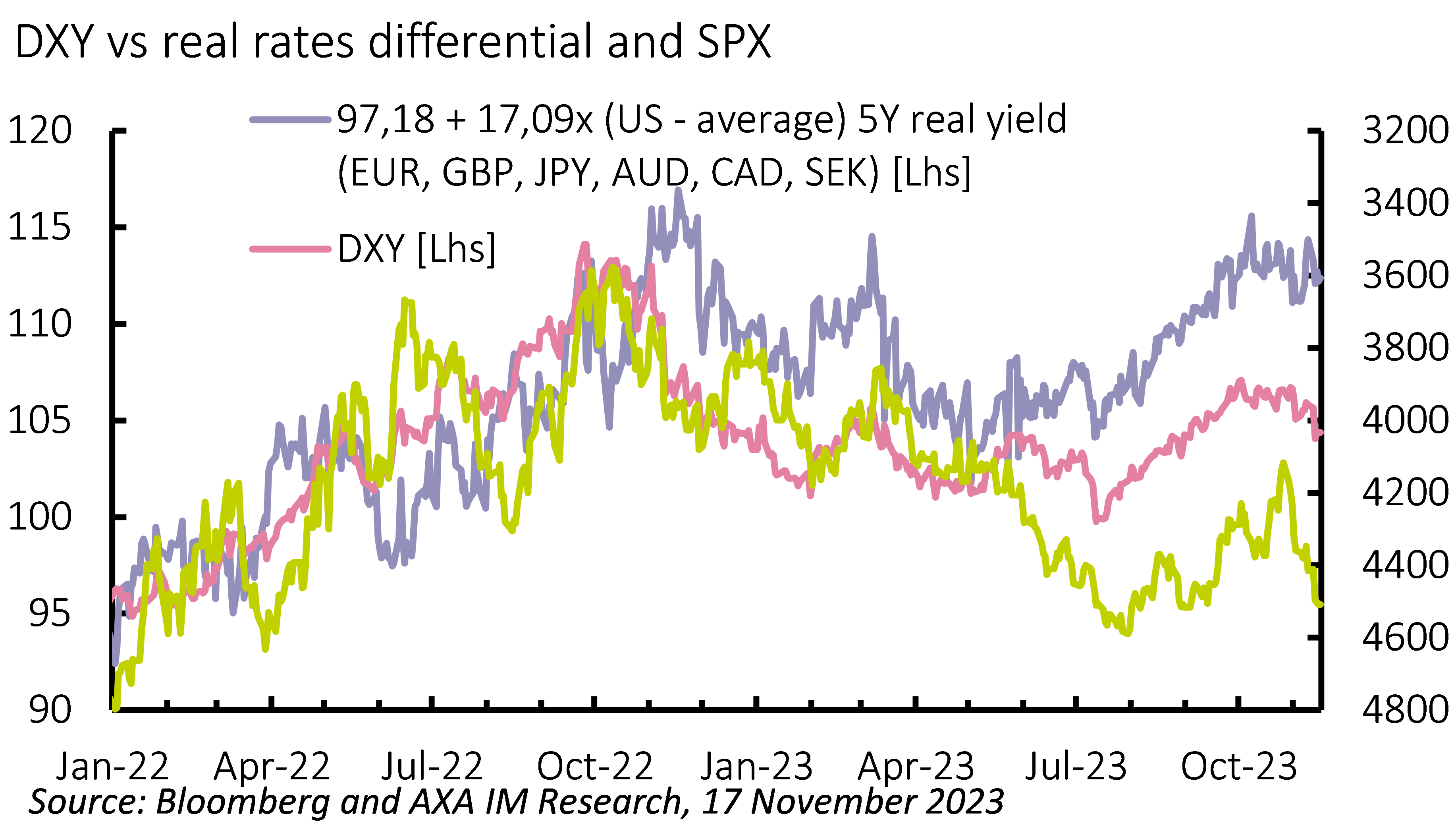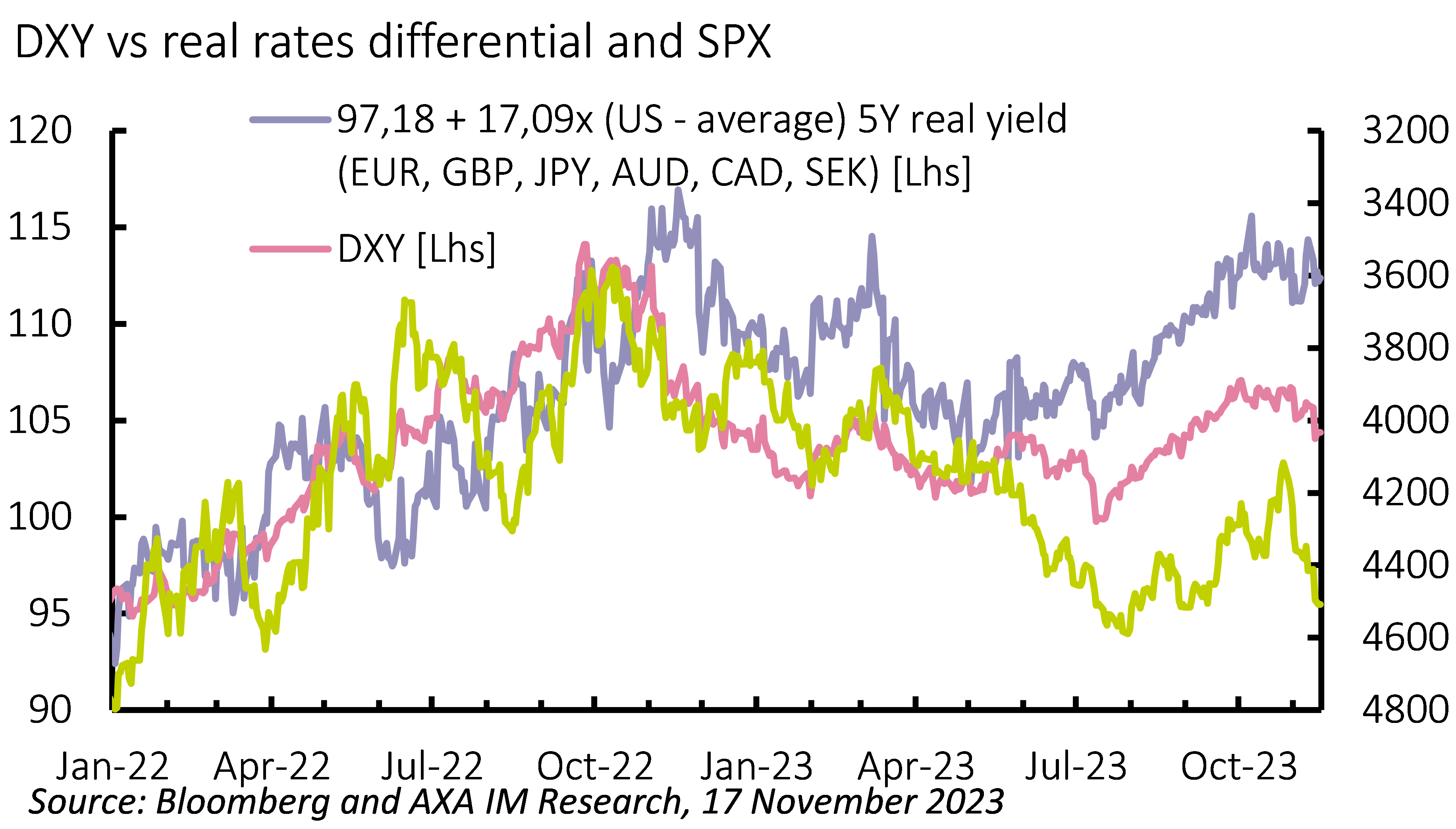
Currencies Outlook – US dollar high(er) for longer
- 01 Dicembre 2023 (5 min di lettura)
Key points
- The US dollar looks set to remain supported by high US yields and a continuation of US’s macro resilience
- Both the euro and sterling are not cheap, with weaker fundamentals and are likely to depreciate
- In a US soft landing scenario, high betas might get a chance to finally shine. The Norwegian krone is particularly cheap
- Japan’s yen might breathe again if rates stop rising, but don’t expect it to steal the show
Fed, not US dollar, peak
After markets’ multiple attempts to call the Federal Reserve's (Fed) last hike in this policy cycle, it seems we have finally reached it. At its last meeting it left policy unchanged at 5.25%-5.50% and while the Fed is reluctant to say it has peaked, we believe it has. Rising US rates have been a key factor behind the US dollar’s (USD) strength in 2023 but it doesn’t mean it is doomed to fall if rates stop rising. Looking at previous cycles (Exhibit 1), there is no clear evidence to suggest this, particularly looking at the 1970s and early 1980s high inflation periods.
Exhibit 1: Fed peak not necessarily leading to USD weakness

US inflation is softening but not yet back to target, and neither the economy nor labour market have materially decelerated. The transmission of tighter policy seems particularly slow and as long as the market keeps pushing back the perspective of rate cuts, the USD will remain supported.
The greenback is undoubtedly not cheap but for good reasons. It has now become the undisputed high yielder within the G10 – even against the renminbi (RMB). Additionally, as mentioned, the US is showing much greater resilience against global monetary policy tightening (Exhibit 2), which supresses the point in the horizon where it might be ousted by foreign yields. Stability in yield differentials might only mean USD stability, not strength. But the market is so far only expecting other central banks to mostly match the Fed’s cut pace, not exceed it.
Exhibit 2: Unrivalled US exceptionalism

Reality check for euro and sterling
The euro (EUR) is firmly in the expensive camp too. When looking at the real effective exchange rate, it has actually appreciated the most amongst the G10 (Exhibit 3). Not only did it depreciate by less than most against the USD but it also endured a much higher PPI-based inflation trend, looking at a seven-year time horizon (both criteria found as the most statistically relevant, focusing on more tradable items).
There are fewer reasons to support such a valuation. The Eurozone economy has slowed more than the US, inflation is falling faster, and European Central Bank (ECB) policy appears more fragile than current Fed pricing, while higher EUR rates would raise further concerns about Italian sovereign debt. Unlike in November 2022, when the prospect of China reopening was boosting global growth forecasts, the potential rebound on this front looks much slower. Indeed, we expect an upcoming growth differential with the US and a renewed focus on ECB balance sheet policy to lead the EUR/USD back towards parity in 2024.
In the post-Brexit world, sterling (GBP) also does not appear to be particularly cheap, although less expensive than EUR. The UK economy has also broadly stagnated over the past 18 months, with the prospect of further weakness ahead. Transmission of Bank of England (BoE) policy tightening is typically faster – the labour market appears to have turned and potential interest rate cuts seem underestimated, relative to other central banks. GBP/USD should also adjust lower.
NOK’ed out but getting up off the canvas
High beta currencies failed to strengthen materially in this cycle and appear – on average – rather cheap. This might in part be explained by their incapacity this time to deliver a higher yield than the dollar. This also might in turn reduce the potential drawdown under risk, from a move towards lower yields.
USD rates have been a dominant driver in 2023 and left little room for high beta currencies with unexceptional yield momentum. Risk sentiment needs to take the driving seat again for those to rise. This might be the turn the USD has recently taken with rising confidence in a soft landing (Exhibit 4).
Australia, New Zealand, Sweden and Norway all have highly indebted households with short-maturity mortgage resets which could lead their economies to decelerate faster. But if a global soft landing emerges Norway’s krone (NOK) has more potential for a comeback from a currently very cheap valuation. Domestic growth looks more resilient than in Sweden. Both the Australian dollar (AUD) and New Zealand dollar (NZD) are also currently impacted by their ties to Chinese growth, although the domestic housing markets appear in better shape.
Exhibit 3: EUR not cheap, but NOK and JPY are

Japan’s yen: Rate differential is yesterday’s enemy
The yen’s (JPY) sharp undervaluation is fully explained by the divergence between Fed and Bank of Japan (BoJ) policy. The USD/JPY has been faithfully tracking the US-Japan 10-year rate differential over the last two years, while the BoJ maintained its yield curve control (and negative rates as the Fed hiked by 525bps, with echoes from other central banks impacting all JPY crosses.
Now the Fed has probably peaked, the next move is for (eventually) lower rates, which should take pressure off the yen and allow some rebound. But as discussed, US rates may remain high for longer – any bounce might be slow and limited, in particular against the USD. And with a 6% adverse carry, there is no incentive to position too early. We do expect the BoJ to shift away from accommodative policies, albeit cautiously, waiting for confirmation on wage growth, while inflation is decelerating globally and not rising locally.
Exhibit 4: USD torn between Rates and Risk drivers

Renminbi’s golden parachute
As with the JPY, policy divergence is the main reason for RMB weakness over the past two years - and there is also a very close link between the 10-year rate differentials and USD/CNH – offshore renminbi (Exhibit 5). The People’s Bank of China (PBoC) is maintaining lower domestic rates to manage the transition and revive its economy. China’s growth failed to rebound as quickly as expected in 2023 after reopening and fiscal support remained limited to avoid reigniting excess leverage until the second half of 2023. Investment flows should remain muted with such low rates and higher geopolitical tensions. The trade balance has also yet to deflate from pandemic-era levels, as global demand decelerates, and China imports rise again.
The PBoC is trying to resist those weakening pressures on RMB by maintaining lower USD/CNY fixing and withdrawing liquidity. This policy might take a heavy toll on foreign exchange reserves if USD rates remain high for longer.
Exhibit 5: PBoC action causing USD/CNH to diverge from rates

La nostra view per il 2024
Vedi tutti i contenuti

Crescita globale rallenta, ma guadagni potenzialmente elevati per le obbligazioni
- A cura di ,
- 05 Dicembre 2023 (7 min di lettura)

Outlook 2024: USA avanti, Europa col freno, no recessione
- A cura di
- 05 Dicembre 2023 (5 min di lettura)

Outlook 2024-2025 (Webinar)
- A cura di
- 05 Dicembre 2023 (15 min di lettura)

I tassi a lungo termine e l’evoluzione del debito negli Stati Uniti e in Europa
- A cura di
- 05 Dicembre 2023 (7 min di lettura)

Investment Strategy Outlook – Modest growth, modest returns
- A cura di
- 04 Dicembre 2023 (7 min di lettura)

Pensions investment outlook 2024: Mining for opportunities amid easing growth
- A cura di
- 04 Dicembre 2023 (7 min di lettura)
Disclaimer
Prima dell’investimento in qualsiasi fondo gestito o promosso da AXA Investment Managers o dalle società ad essa affiliate, si prega di consultare il Prospetto e il Documento contenente le informazioni chiave per gli investitori (KID). Tali documenti, che descrivono anche i diritti degli investitori, possono essere consultati - per i fondi commercializzati in Italia - in qualsiasi momento, gratuitamente, sul sito internet www.axa-im.it e possono essere ottenuti gratuitamente, su richiesta, presso la sede di AXA Investment Managers. Il Prospetto è disponibile in lingua italiana e in lingua inglese. Il KID è disponibile nella lingua ufficiale locale del paese di distribuzione. Maggiori informazioni sulla politica dei reclami di AXA IM sono al seguente link: https://www.axa-im.it/avvertenze-legali/gestione-reclami. La sintesi dei diritti dell'investitore in inglese è disponibile sul sito web di AXA IM https://www.axa-im.com/important-information/summary-investor-rights.
I contenuti pubblicati nel presente sito internet hanno finalità informativa e non vanno intesi come ricerca in materia di investimenti o analisi su strumenti finanziari ai sensi della Direttiva MiFID II (2014/65/UE), raccomandazione, offerta o sollecitazione all’acquisto, alla sottoscrizione o alla vendita di strumenti finanziari o alla partecipazione a strategie commerciali da parte di AXA Investment Managers o di società ad essa affiliate, né la raccomandazione di una specifica strategia d'investimento o una raccomandazione personalizzata all'acquisto o alla vendita di titoli. L’investimento in qualsiasi fondo gestito o promosso da AXA Investment Managers o dalle società ad essa affiliate è accettato soltanto se proveniente da investitori che siano in possesso dei requisiti richiesti ai sensi del prospetto informativo in vigore e della relativa documentazione di offerta.
Il presente sito contiene informazioni parziali e le stime, le previsioni e i pareri qui espressi possono essere interpretati soggettivamente. Le informazioni fornite all’interno del presente sito non tengono conto degli obiettivi d’investimento individuali, della situazione finanziaria o di particolari bisogni del singolo utente. Qualsiasi opinione espressa nel presente sito internet non è una dichiarazione di fatto e non costituisce una consulenza di investimento. Le previsioni, le proiezioni o gli obiettivi sono solo indicativi e non sono garantiti in alcun modo. I rendimenti passati non sono indicativi di quelli futuri. Il valore degli investimenti e il reddito da essi derivante possono variare, sia in aumento che in diminuzione, e gli investitori potrebbero non recuperare l’importo originariamente investito.
Ancorché AXA Investment Managers impieghi ogni ragionevole sforzo per far sì che le informazioni contenute nel presente sito internet siano aggiornate ed accurate alla data di pubblicazione, non viene rilasciata alcuna garanzia in ordine all’accuratezza, affidabilità o completezza delle informazioni ivi fornite. AXA Investment Managers declina espressamente ogni responsabilità in ordine ad eventuali perdite derivanti, direttamente od indirettamente, dall’utilizzo, in qualsiasi forma e per qualsiasi finalità, delle informazioni e dei dati presenti sul sito.
AXA Investment Managers non è responsabile dell’accuratezza dei contenuti di altri siti internet eventualmente collegati a questo sito. L’esistenza di un collegamento ad un altro sito non implica approvazione da parte di AXA Investment Managers delle informazioni ivi fornite. Il contenuto del presente sito, ivi inclusi i dati, le informazioni, i grafici, i documenti, le immagini, i loghi e il nome del dominio, è di proprietà esclusiva di AXA Investment Managers e, salvo diversa specificazione, è coperto da copyright e protetto da ogni altra regolamentazione inerente alla proprietà intellettuale. In nessun caso è consentita la copia, riproduzione o diffusione delle informazioni contenute nel presente sito.
AXA Investment Managers può decidere di porre fine alle disposizioni adottate per la commercializzazione dei suoi organismi di investimento collettivo in conformità a quanto previsto dall'articolo 93 bis della direttiva 2009/65/CE.
AXA Investment Managers si riserva il diritto di aggiornare o rivedere il contenuto del presente sito internet senza preavviso.
A cura di AXA IM Paris – Sede Secondaria Italiana, Corso di Porta Romana, 68 - 20122 - Milano, sito internet www.axa-im.it.
© 2024 AXA Investment Managers. Tutti i diritti riservati.